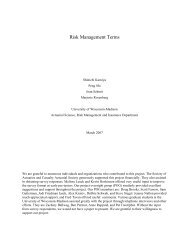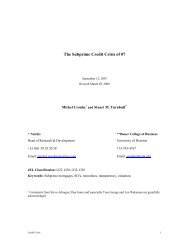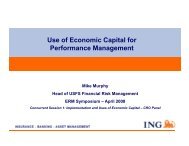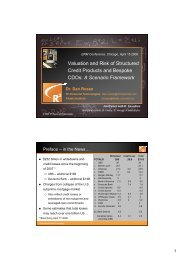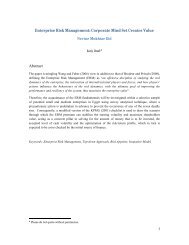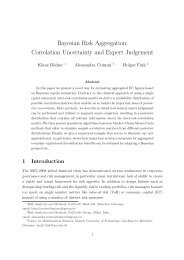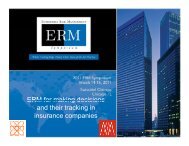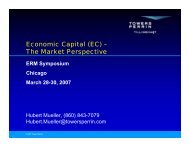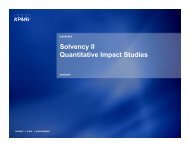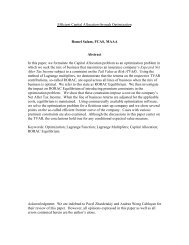An Empirical Map of Enterprise Risk Space for ... - ERM Symposium
An Empirical Map of Enterprise Risk Space for ... - ERM Symposium
An Empirical Map of Enterprise Risk Space for ... - ERM Symposium
Create successful ePaper yourself
Turn your PDF publications into a flip-book with our unique Google optimized e-Paper software.
(e) corr(ξi, εj) = 0 <strong>for</strong> all i,j 6<br />
(f) [Initially] corr(ξi, ξj) = 0 <strong>for</strong> all i,j, i ≠ j. I.e., the initial extracted factors are uncorrelated<br />
(orthogonal).<br />
Results <strong>of</strong> Factor <strong>An</strong>alysis within the <strong>Risk</strong> Clusters and <strong>ERM</strong> Clusters -- Creation <strong>of</strong> the <strong>Risk</strong><br />
and <strong>ERM</strong> Tools <strong>Map</strong>s<br />
We look to the first few factors to determine the meaning <strong>of</strong> the cluster. The first few factors are<br />
usually responsible <strong>for</strong> a substantial proportion <strong>of</strong> the variability <strong>of</strong> the cluster variables (denoted<br />
by the eigenvalue). <strong>An</strong>d the meaning <strong>of</strong> a factor can be gleaned from the variables with highest<br />
factor loadings. For those clusters with high eigenvalues (high variance explained by each<br />
factor), Table 3 shows the loadings <strong>for</strong> the most significant factors in each <strong>of</strong> the <strong>of</strong> these risk<br />
clusters. We also provide our interpretation <strong>of</strong> the resultant themes <strong>of</strong> the clusters.<br />
Table 3 - <strong>Risk</strong> <strong>Space</strong> - Factor Loadings <strong>for</strong> the Clusters with High Variance Explained by<br />
the Factors (Eigenvalues) and their Themes<br />
Cluster 1<br />
Factor Number Eigenvalue<br />
1 9.696722<br />
2 3.746450<br />
3 2.679885<br />
Theme<br />
Variable Factor1 Low Liquidity – Asset risk<br />
LAtotal 0.876416<br />
LAInvestedAssets 0.841905<br />
LpBond2Private 0.818397<br />
LpBprivate 0.818267<br />
LWtotal 0.753522<br />
LpBond1Private 0.737044<br />
LpBond3Private 0.715046<br />
Variable Factor2 Life product risks<br />
LpAPolicyLoans 0.523196<br />
5 This is a natural assumption: If two ε‘s could be correlated, then part <strong>of</strong> their effects would be in common to their<br />
two X-variables and not unique to their separate X-variables.<br />
6 This is a natural assumption: If a common factor correlates with another unique factor, then that other unique<br />
factor is not unique to its X-variable, but also shares in the explanation <strong>of</strong> the X-variable <strong>of</strong> the common factor. <strong>An</strong>d<br />
if a common factor correlates with its own unique factor, then that unique factor necessarily correlates with another<br />
X-variable (because the common part is, after all, in common to the X-variables), and so is also not unique.<br />
17



